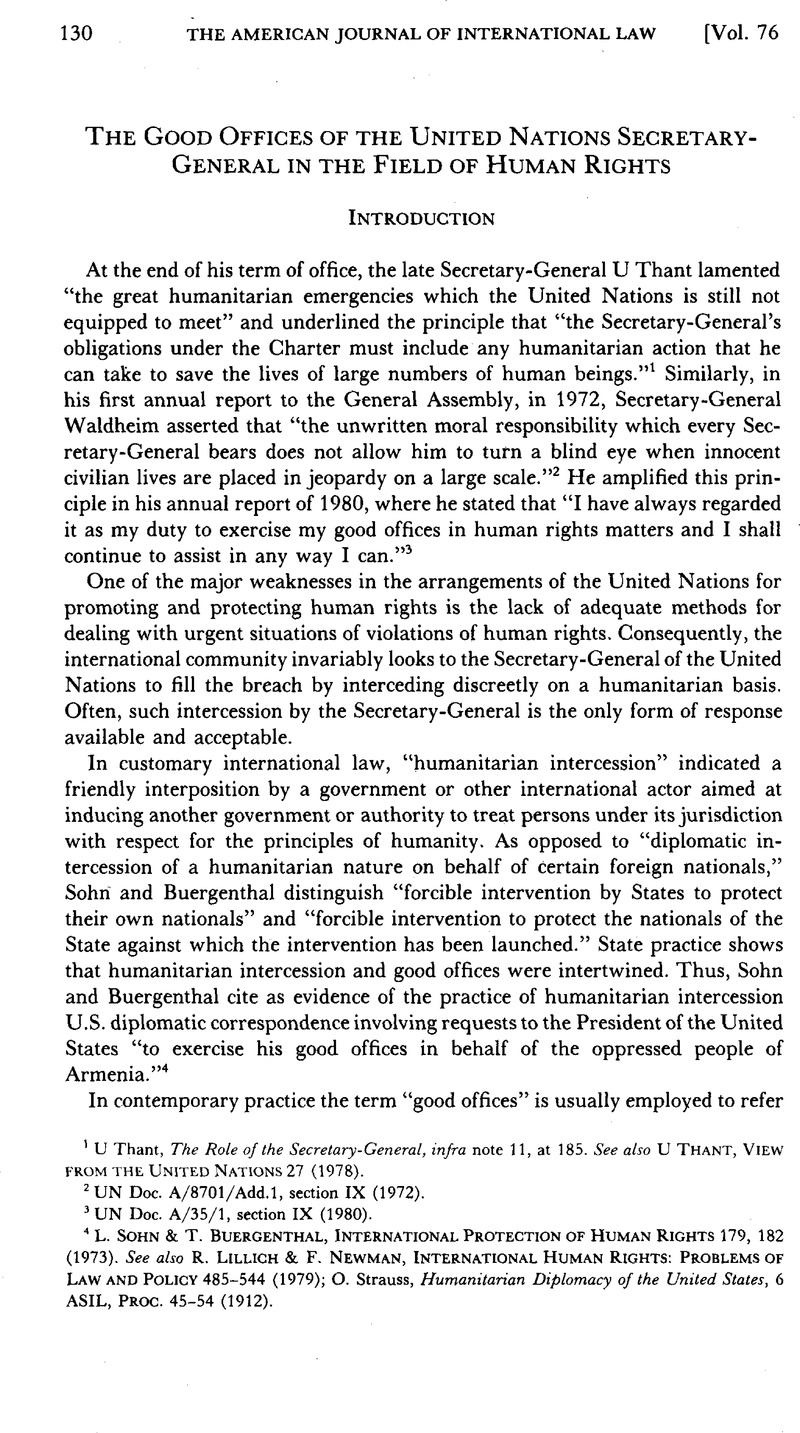No CrossRef data available.
Published online by Cambridge University Press: 27 February 2017

1 U Thant, The Role of the Secretary–General, infra note 11, at 185. See also U Thant, View From the United Nations 27 (1978).
2 UN Doc. A/8701/Add. 1, section IX (1972).
3 UN Doc. A/35/1, section IX (1980).
4 L. Sohn & T. Buergenthal, International Protection of Human Rights 179, 182 (1973). See also R. Lillich & F. Newman, International Human Rights: Problems of Law and Policy 485–544 (1979); Strauss, O., Humanitarian Diplomacy of the United States, 6 ASIL, Proc. 45–54 (1912)Google Scholar.
5 See UN Press Release SG/SM/699, April 29, 1967.
6 UN Doc. A/C3/35/L.78 (1980).
7 For the records of the discussion, see UN Doc. A/C3/35/SR.56–62 (1980).
8 V. Pechota, the Quiet Approach: A Study of the Good Offices Exercised by the Secretary–General in the Cause of Peace 13 (UNITAR 1972). See similarly Darwin, Mediation and Good Offices, in International Disputes: The Legal Aspects 83 (Report of a Study Group of the David Davies Memorial Institute of International Studies, 1972). Cf. ch. III (Good offices), Art. 10(1), of the Second Report on the Peaceful Settlement of International Disputes, in International Law Association, Report of the 56th Conference 43, 48 (1974).
9 V. Pechota, supra note 8, at 2.
10 Id. at 17.
11 Ibid. On the good offices of the Secretary–General generally, see Simmonds, , Good Offices and the Secretary–General, 29 Nordisk Tidsskrift for International Ret og Jus Gentium 330 (1959)Google Scholar; U Thant, , A Quiet United Nations Road to Accord, UN Monthly Chronicle, No. 7, July 1970, at 122 Google Scholar; U Thant, , The United Nations and some problems of public understanding, id., No. 1, Jan. 1971, at 98 Google Scholar; U Thant, The Role of the Secretary–General, id., No. 9, Oct. 1971, at 178.
12 See especially Council resolution of June 27, 1921, referred to in The International Protection of Minorities, note 13 infra, at 27.
13 See The International Protection of Minorities under the League of Nations 27–32, UN Doc. E/CN.4/Sub.2/6 (1947). See also P. De Azcarate, League of Nations and National Minorities: An Experiment (1945); J. Barros, Office Without Power: Secretary–General Sir Eric Drummond, 1919–1933, at 97–98 (1979).
14 See ILO Doc. GB/205/21/7: past practice concerning special inquiries with particular reference to human rights questions, paras. 27–29.
15 Aga Khan, S., Legal Problems Relating to Refugees and Displaced Persons, 149 Recueil Des Cours 287, 349 (1976 I)CrossRefGoogle Scholar.
16 D. Tansley, Final Report: An Agenda for the Red Cross: Re–Appraisal of the Role of the Red Cross 72 (1975). See also D. P. Forsythe, Present Role of the Red Cross in Protection 30–48 (Background Paper No. 1 of the Joint Committee for the Re–appraisal of the Role of the Red Cross, 1975).
17 H. Lauterpacht, International Law and Human Rights 187 (1950). See also L. Goodrich, E. Hambro, & P. Simons, The Charter of the United Nations (1969); Schwebel, , The Origins and Development of Article 99 of the Charter, 28 Brit. Y.B. Int’l L. 371 (1952)Google Scholar.
18 12 UN GAOR (690th plen. mtg.), paras. 72–73 (1957).
19 V. Pechota, supra note 8.
20 Secretaries–General of the League of Nations also made intercessions on humanitarian matters. See, e.g., on the humanitarian efforts of Secretary–General Drummond, J. Barros, supra note 13, at 105–06.
21 T. Lie, In the Cause of Peace 243 (1954).
22 Id. at 289.
23 Id. at 304.
24 Id. at 242–43.
25 B. Urquhart, Hammarskjöld 496–97 (1972). See also, on Hammarskjöld’s exercise of good offices in general, pp. 308–14.
26 The Israeli Ambassador.
27 U Thant, supra note 1, at 351–52. In the UN relief operations to Bangladesh (1971), Secretary–General U Thant, relying upon the purposes of the Charter, invoked his responsibility to ensure that human well–being was protected and humanitarian principles upheld. See Morse, , Practice Norms and Reform of International Rescue Operations, 157 Recueil Des Cours 121, 150 (1977 IV)CrossRefGoogle Scholar.
28 U Thant, A Quiet Road, supra note 11, at 124–25.
29 See, in particular, UN Docs. A/8701/Add.1, section IX (1972); A/9601/Add.1, at 8 (1974); A/31/1/Add.1, at 9 (1976); A/32/1, at 6–7 (1977); A/33/1 (1978); A/34/1 (1979); A/35/1, section IX (1980); OPI/622, at 16–17 (1978); UN Press Release SG/SM/321, at 6 (1977).
30 K. Waldheim, Un Métier unique au monde 102 (1978).
31 UN Doc. A/10295 (1975).
32 See para. 43 of the ICJ Judgment in the Case Concerning United States Diplomatic and Consular Staff in Tehran (USA v. Iran), [1980] ICJ Rep. 3, reproduced in UN Doc. S/13989 (1980), 74 AJIL 746 (1980).